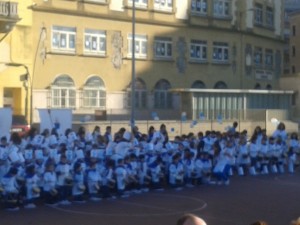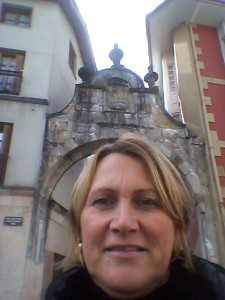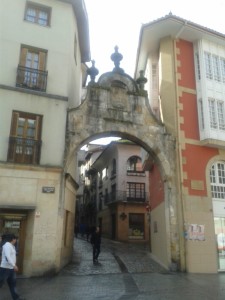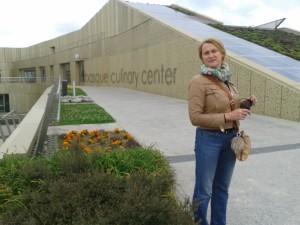- Arantzazu – sacred place for Basques, along with San Sebastian located on a pilgrim route to Santiago de Compostela
Arantzazu, in the Basque language means a place full of hawthorn bushes, is a church situated in stunning mountains.
In the course of its history, Arantzazu was ravaged by three major fires, the last of which was in 1834 when the Sanctuary was burnt to the ground. 1950 marked the start of the construction of the modern basilica which is a brilliant example of contemporary Basque art erected on a ravine, its stone structure rises imposingly up from the rocks.
The survival of the Basque language was threatened for centuries by both Spanish and French, particularly under the rule of Franco, during which the Basque language was prohibited and came close to extinction in Spain. Consequently, the Basque Language Academy felt the need to create a unified dialect of Basque, so that the language had a greater chance of survival. The 1968 Arantzazu Congress took place in the sanctuary of Arantzazu, where the basic guidelines were laid down, therefore Arantzazu is considered as a sacred shrine of the Basque language.
For the Basque language revival was utmost important the establishment of schools, known as ikastolas, where now for nearly 20 years the education is conducted solely in the Basque language. I dare to say our children’s first language is Euskera. Needless to say, it is an entirely secret language between two siblings of which their parents do not understand a single word although they speak several other languages themselves. Leo, our 6-year old, has even started to read and write in Euskera.
- Gastronomic societies: what is Tamborrada?
Gastronomic societies – total of 1552 in Basque country out of which 119 are in Donostia – play an enormously important part in San Sebastian’s social life. Here, members meet in a club complete with a kitchen for lunch or dinner, either with other members of the society or with their families and/or friends. This said, gastronomic societies are often much more than simply a meeting place for their members; they organise cultural activities central to the social and leisure aspects of life in the city, particularly forming companies of tamborrada drummers. In fact, most of the adult companies that parade through the streets on San Sebastián Day on 20 January belong to the gastronomic societies.
When you go to a gastronomic society in San Sebastian (which you can only do by invitation by a member, except on San Sebastian Day), the cooking is usually done by 2 or 3 of the diners who bring along their own food for the purpose (although the basics are generally available in the society kitchen larder). After eating, the costs are calculated and split among everyone eating at the table. These costs include items like the right to use the kitchen and its utensils, a symbolic charge per attendee, and the cost of all products taken from the pantry or cellar. All of the documents and cash to pay the bill are placed in a special box before leaving the society premises.
Given that this is a system based on trust and self-management, gastronomic societies have a very strong family feel to them and tend to be considered by the members and their guests as a place mid-way between their homes and a restaurant. The friendly atmosphere often means that lunches and dinners end with games of cards or singing, either with fellow diners or with people at other tables. Having lunch or dinner at a gastronomic society is just about the closest you’ll ever get to the cultural life in San Sebastian.
And that explains that our exposure to sociedas has been limited. We were invited a couple of times to have a meal in various sociedas and always agreed these places have special ambience indeed.
For the Basques tamborradas, the celebration of the name day of San Sebastian is more important than Christmas. They cook a truly extra dinner including the most expensive fish: angulas.

For us it is always a cultural experiment to see our children Flora and Leo dressed as cooks and drumming during their ikastola’s (school’s) performance.
- Basque culinary centre (or Faculty of Gastronomic Sciences)
The Basque Culinary Center also known as The Faculty of Gastronomic Science, opened in 2011 and is the second gastronomic university in Europe. It is a part of Mondragon University and offers professional degrees in the culinary arts. The Basque Culinary Center is also dedicated to research and knowledge-sharing among haute-cuisine professionals and the business sectors related directly or indirectly to gastronomy, always with an eye on the international scene.
I have taken advantage of the availability of a great selection of non- professional courses, so called courses for enthusiasts, from which I have become a culinary enthusiast myself. I can highly recommend these courses, though if you plan to enrole you must bear in mind they are mostly conducted in Spanish language, though some classes are taught in English in the summer.
Another perhaps risky yet unique experience is to book, of course a month in advance, a degustation lunch menu for euro 20 or daily menu for euro 10 (without drinks), prepared by professional students –future professional cooks in training.
- Sidreria / Sagardoetxea / Cider house
There are around 130 sidrerias in the Basque country with an official season from 23 January until 30 April although some sidrerias are open all year. It is a place where you are always offered the same food menu and local cider from the barrels to drink. Typical cider house menu is tortilla de bacalau, bacalau with green peppers, txuleta and cheese with nuts accompanied with a simple white baguette. During your dinner, which in typical sidrerias you are asked to share from the same plate with your guests, you are prompted by the “whistle / txotx” to taste various ciders from the barrels.
There is also also Museo de la Sidra, Kale Nagusia 48, 20115 Astigarraga, Tel: 00 34 943 550 575., info@sagardoetxea.com, www.sagardoetxea.com.
Sagardoetxea, the Basque Cider Museum, is the ideal place for an introduction to cider culture and to learn about the secrets of cider tasting before visiting a cider house. This experience, joining together a museum and a cider house, offers the opportunity to get to know the whole process of cider making, the history and the tradition of this ancient drink, the secrets that accompany cider tasting “al txotx”, and culminates in a visit to a traditional sidreria / cider house.
For us the biggest surprise was the fact that in the real tradional sidrerias you have no chairs and you must stand at all times. Yet, the excellent simplicity and outstanding quality of the food with the cider will surely keep you going and it is an experience not to be missed in the Basque country.
- Local / Rural markets around San Sebastian
Where does the secret of the fine food in the Basque country begin? With the genuine products from the food markets. Here are few tips:
Biggest market in San Sebastian – La Bretxa – worth visiting everyday apart from Sunday, when it is closed, and Monday when most of fish shops are closed. Do not miss the great bar Azkena.
When you arrive at the Market in Ordizia on Wednesday and you see the high columns, the image of an ancient Roman temple will surely pop on your mind. And that what it is, a temple of Basque food. Similar feelings arise when visiting a Saturday market in Tolosa.
When we feel we need to take some cosmopolitan air we drive to visit a market on Sunday in the nearby French city of Biarritz. Although it is open on Sundays, it closes at 1pm. It’s a place where a multicultural ambience is evident at first sight. We shall treasure the memories of enjoying fresh oysters & shrimp with a zip of white wine.
- Basque rural villages – Alkiza / Albiztur / Beizama
To get the gist of the typical Basque village with their typical squares and pelota courts, caserios/country houses and at the same time enjoy the stunning mountains and eating local delicious txuleta visit:
Beizama
A village hidden in the Pyrenees between patxaran bushes used for a production of patxaran – Basque liquor – where we first arrived with our 6-week old Flora.
There’s only one restaurant, located in a municipality house that serves a mixed salad, txuleta and tarta de queso to dream about – with an extended terrace overlooking the hills
And nearby Albiztur where they serve typical tolosa beans.
Two years ago, in a hospital, of all places, we met the most open and friendly locals ever, Aitor, (the most popular male Basque name) and his sister Joaine. Since our first meeting we have exchanged several visits. It always feels special to go to Joiane’s etxea, called Peru, to visit her family – her husband Aitor, and their two sons, Aitor and Urtzi–in the mountain village of Alkiza 30km/30min. away. It’s definitely our favourite Basque mountain village in a stunning mountain environment.
- Basque ports – Getaria & Hondarribia / Fuenterrabia
Getaria
This picturesque fishing village has escalators and steps leading you to the very modern Cristobal Balenciaga Museum, opened in 2011. What an architectural contrast to the old buildings of this medieval fishing settlement. The Museum is a must for anyone interested in fashion and design. It is closed on Mondays.
With all our visitors we rarely miss the opportunity to have at least a quick stop in this charming village (where, by the way, the Belgium queen spends her holidays). We go to the local shop by the port with antxoas, tunas and txakoli and other local delicacies. If you fancy a less fancy lunch have a rape/monk fish prepared on barbeque by the sea. If you fancy a more fancy lunch have whole turbot cooked on the charcoal grill and served on the bone go to Elkano.
Hondarribia /Fuenterrabia – a special spot between Spain and France by the sea
Hondarribia is a town that guards itself from the dangers that come by sea, and protects the medieval treasure that is its old quarter with the remnants of thick, high walls. It’s important to keep in mind it is also the location of the airport closest to San Sebastian. Outside the walls, you find a seaside village with colorful, eye-catching houses, lively taverns and beautiful views of the sea. In Hondarribia there is also a member of the hotel chain that was established by the Spanish state to support tourism in various regions: a hotel Parador. This one is also known as the Castle of Charles V, its construction dates to the 10th century. Here you will feel as if you are in an authentic medieval fortress. The views of the coast of France and the sea from some of the guest rooms and the terrace complete the indescribable beauty of this place.
We can recommend whilst wandering the cobble stone streets in the old centre on the cobble stones to stop to have a drink in the Parador and appreciate the ambience of living in the old times. And then continue walking towards the seaside where you can hop on a little boat which takes you on the French side, or simply enjoy a seaside stroll.
8. Pasaia
At first sight, this coastal working-class village aligned with the Basque separatist movement has very little to recommend it. But Pasaia’s blend of genres – from the old sailors’ manors to the commotion of the docks – produces an inexplicable charm that once captivated Victor Hugo.
An Independent municipality, although it used to be the port for San Sebastian it still feels like a truly independent village. There is a natural fiord and within the activities of the ECoC 2016 the whaleboat “San Juan” is being rebuilt here and in addition the old relevant traditions are being revived.
- La Rhune – a special spot between Spain and France in the mountains
When you take the “Petit Train de La Rhune” that dates from 1924, you will discover the breathtaking views of La Rhune, a mountain in the Basque Country, whilst on a 35 minute ride, traveling at a speed of 9km an hour.
| La Rhune overlooks the Basque Country from a height of 905 metres, thus offering one of the loveliest panoramic views. Look around you, and see the seven provinces of the Basque Country, the peaks of the Pyrenees, the outstretched beaches of the Landes region, and the Basque coastline from Biarritz to San Sebastian. |
It is a worthwhile trip and manageable with kids, but bear in mind long queues which might be avoided by buying tickets over the internet.
- Bilbao & surrounding – Guggenheim Museum & Oma Painted Forest (Bosque pintado)
Hailed as the most important structure of its time when it opened in 1997, Frank Gehry’s Guggenheim Museum Bilbao has changed the way people think about museums and continues to challenge assumptions about the connections between art, architecture, and collecting.
Yet, talking to locals, we are aware of the never ending debate / mixed feelings about the impact of this huge investment of the city and the way it negatively influenced other cultural activities.
The peaceful town of Kortezubi, right in the heat of the Urdaibai Biosphere Reserve, has a hidden treasure that combines art, nature and a connection with the artistic endeavours of our earliest ancestors. It is the Oma Painted Forest, where Agustín Ibarrola, the painter and sculptor, has turned the landscape into the frame, medium and raw material of one of his best known works. Visiting this unique “open air museum”, where there is no entry charge, involves going on a peaceful walk among pine trees and ferns, as you look for the trunks transformed by the artist’s paintbrushes and where he plays with the point of view and depth.
A real pleasurable walk through beautiful nature manageable with kids 4 years older however when the weather permits.
- The Mondragon myth
The Mondragon Group of worker cooperative enterprises began with a single company and two dozen people in 1955-56 and today has around 74 000 employees. Among the key values are cooperation between owners and workers, preferably workers are members, participation in management, social responsibility including involvement in the community and constant innovation.
Along with democratic governance, egalitarianism is important for cooperative philosophy and it is put into practice through a policy of remunerative solidarity, that is, a relatively compressed compensation scale from 6:1 (highest : lowest salary). Also important cooperative policy concerns employment stability and lay-offs. A worker-member cannot be let go for motives related to the company’s economic performance and must be transferred to another coop. If not, they are paid 80% of their wages until such a transfer or return to work is possible. Last but not least, there are in place schemes for solidarity in profit distribution as well as in loss distribution whenever losses happen.


Living in the Basque country with 2.2mil inhabitants in the province of Gipuzkoa with its 710.000 inhabitants where the Social economy accounts for 10% of employment or you could say there are 15 jobs in the Social economy per square kilometre, I was eager to learn more about the Basque Valley also known as Silicon Valley. When we started our discussion with Professor Fred Freundlich, Mondragon University’s guru on co-operatives, we voiced our deep concern about the enormously widening income gap in a global society and growing importance of implementation of the principle of employee participation. Therefore, the co-operative system so extensively established in Mondragon in the Basque country, although it is not a paradise, seems to be a more human system than the common private business model. That view was first expressed to me by Mikel Lezamiz, the real co-operativista from Mondragon.
I have decided the Basque Country makes an excellent case study since there are some interesting parallels between my native Czech Republic and this region in the north of Spain. It experienced 40 years ago a transition from an authoritarian regime to democracy in some ways comparable to that experienced by Czech society 25 years ago. Second, the Basque Country is today a comparatively wealthy European region, with an important concentration of metallurgic industry and manufacturing SMEs.
- Calle San Blas in Southwest
From our street we have view of one of the beaches Zurriola and can observe those brave surfers in the Atlantic Ocean all year along as well as the mountains that ring the city. Our neighbourhood used to be a rough area, still remembered by some old inhabitants of our street, but where nowadays live a real mixture of people from all walks of life. In front of our house is a cosy small square with several benches occupied by all which makes it an incredible social laboratory. This is where we learnt to appreciate the outdoor Spanish way of life. The discretely located, yet public, elevator built on the side of the recently-built school gives easy access to the beach. We have within a couple of hundred metres of our apartment a court for local Basque game called pelota, we also have the ikastola where Leo and Flora master with ease education in Euskera and the adjacent church where Flora was baptised. On numerous occasions pilgrims headed for Santiago de Compostela wander off their route and end up in our street asking for directions.
- La Perla – not only for the time when sun is not shining
La Perla Thalassotherapy is a genuine relic of the belle époque of San Sebastian. More than one century ago, the queen Maria Cristina established the royal summer house in this city. Sea baths were considered to be a fine pleasure by holidaymakers, a pleasure that combined therapy, relaxation and wellness.
La Perla Thalasso is located in the incomparable surroundings of La Concha Bay. Regarded as the best Thalassotherapy Urban Spa of Europe, for 2 hours for euro 26.50 you find a magic combination of salt water baths and body toning programmes. The facilities have a view of the beach, as well as direct access to it.
This is a marvellous spot where I can recommend to escape for 2 hours to enjoy the various therapy and breath-taking views.
- Best viewpoints overlooking the beauties of San Sebastian & surroundings – from Monte Igueldo & Monte Ulia
Strolling along the La concha & Ondarreta beaches, taking a funicular to the top where is an old amusement park and a lookout tower with the old photographs of San Sebastian, to see the most stunning views, accompanied by the old photographs, is a great way to be introduced to the city.
Walk down or take a funicular and go to see the statue by the most famous Basque sculptor Eduardo Chillida – and his bronze statue is the perfect example of beauty in its purest state, a profound dialogue between art and the landscape on the rocks washed with ferocious ocean waves.
We never get tired of wandering or cycling along the local 3 beaches – Zurriola, La concha & Ondarreta. Zurriola, closest to our home, it is a surfers’ paradise and our local playground / sandpit if you will. A lot of our visitors rent a bike and join us. Then we cycle to the end of Ondarreta beach and take the funicular. We enjoy the stunning views, take the best photos and on the weekends must not miss the old amusement park. Then we either treat ourselves to refreshment in the bar or restaurant Branka, or in the restaurant Tennis Ondarreta.
You can always drive up the mountain Igueldo which we also sometimes do, but admittedly we more often drive up the opposite mountain of Ulia. In this protected natural resort is a youth hostel that includes a bar where during the season, or out of season on the weekends, you can get refreshment whilst enjoying the breath-taking scenery.
- From 16 Michelin stars to Pintxo pote on every Thursday
In fact, of the seven 3-Michelin star (the highest there is) restaurants in Spain, three are here in our city, home to great selection of establishments holding a total of 16 Michelin stars, where you can enjoy the excellent fare dished up by the city’s culinary artists. San Sebastián is one of the cities in the world to hold the highest number of Michelin stars per square metre (only beaten by Kyoto in Japan, and well ahead of cities like Paris and Lyon). But the local haute cuisine is not only recognised by the Michelin Guide; the list of the top 50 restaurants in the world published by the magazine, Restaurant, considers the Mugaritz, run by Andoni Luis Aduriz to be one of the best in the world since 2006, and the third best restaurant in the world since 2011. Also since 2006, Arzak has ranked among the 10 best restaurants in the world, and in 2012, Elena Arzak, fourth generation in the family of restaurateurs, was named the world’s best female chef.
I am by no means a Michelin professional. I dare to say I have become a professional enthusiasta, as they call us in the Basque Culinary Centre, one who appreciates good food.
I was fortunate during our years here to visit several of the local restaurants, including those with Michelin stars. Although I certainly can appreciate innovative cooking, my admiration goes to simple cooking from real ingredients that are cooked over a fire with just a hint of oil or salt. This is what real cooking is and what we are losing in the quest for the latest techniques of cooking or presenting food while not knowing what we are actually eating.
I will remember with fondness the tradition of local restaurants on Thursdays when most serve a pintxo and drink for Euro2 which brings particularly crowds of youngsters together out.
- Pintxo – local Basque tapas – pintxo culture is about being on foot and on the move
Today it’s a way of socialising and having a good time. Like to come along? There was published last year an article even in the Financial Times called Passport for the palate. These are recommendations from our palate:
6+1 Favourite pinxo bars plus sweet cherry on the top: the Basque habit is to take one or two pintxos per bar)
- If it is a pintxo tour during lunch time begin in the bar inside the local market
Azkena, Mercado la Bretxa (inside the market), Planta Baja, tel. 615 792 655 – black pudding / mortilla pintxo
- If it is a dinner tour begin in
Borda Berri, Calle Fermin Calbeton, 12 – octopus with quince and the beef carrilleras (cheeks) in red wine
- Bar Zeruko, Calle Pescaderia 10, 943 423 451 – tostada con bogavante / lobster
- Bar Astelena , Plaza Constitución 1, tel. 943 425 245 – brochetas de setas y bacon or gambas / skewers with oyster mushrooms and bacon or prawns
- Ganbara, C/San Jeronimo 19, tel. 943 42 25 75 – seasonal mushrooms / hongos a la plancha or guilda
- Gandarias, Calle 31 de Agosto, 25, tel. 943 42 63 62 – filet mignon / solomillo con pepper
- La Cuchara de San Telmo – filet mignon with foi / solomillo con foi
- La Vina, Calle 31 de Augosto – tarta de queso / cheesecake
